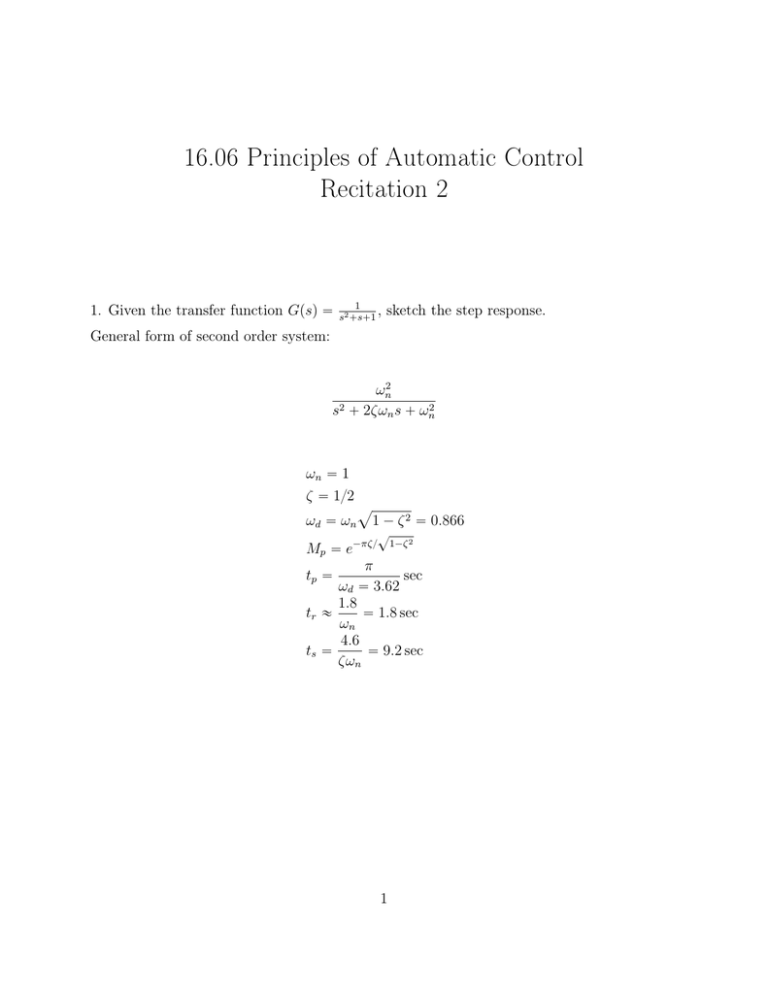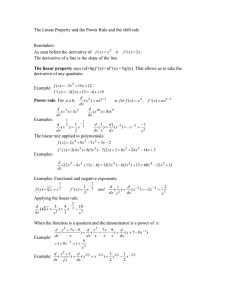Document 13475651
advertisement

16.06 Principles of Automatic Control
Recitation 2
1. Given the transfer function Gpsq “
1
,
s2 `s`1
sketch the step response.
General form of second order system:
ωn2
s2 ` 2ζωn s ` ωn2
ωn “ 1
ζ “ 1{2
ωd “ ω n
a
1 ´ ζ 2 “ 0.866
?
2
Mp “ e´πζ{ 1´ζ
π
sec
tp “
ωd “ 3.62
1.8
tr «
“ 1.8 sec
ωn
4.6
ts “
“ 9.2 sec
ζωn
1
r
2. What if
Gpsq “
s2
s`1
1
` 2
?
` s ` 1 s ` s ` 1
Recall that in Laplace domain multiplying by s is equivalent to taking derivative in time.
We can easily graph this step response by plotting the derivative and the function and then
adding them together.
2
The system in this number Gpsq “ ps ` 1q{ps2 ` s ` 1q is the same system as in #1, but with
an additional zero at s “ ´1. We note that in the step response, the addition of this zero
results in a faster rise time but also in a higher percent overshoot.
To obtain approximation for the peak of the “derivative curve”, we can use the rise time to
estimate the average slope around the inflection point. So average slope is:
slope “
p0.9 ´ 0.1q
0.8
“
“ 0.44
tr
1.8
But since this is the average slope, the maximum slope will be higher, i.e. « 0.5 ´ 0.6 (0.55
in this case).
Also, note that the 2 curves intersect at the maxima and minima (since the derivative curve
has value zero there). This implies that the peaks of the second curve are greater, i.e. the
addition of the zero has increased the overshoot (which is a bad thing), but it has also sped
up the system (which can be a good thing). Lesson here: one must also consider the effect of
the zeros and not only that of the poles (see future class notes and lectures for more details).
Another point here: the slope of the derivative curve is discontinuous at t “ 0, while the
slope of the original curve is continuous at t “ 0.
The function
s`1
s2 `s`1
The function
1
ps2 `s`1q
has two poles and one zero, and thus is of relative degree 1.
has 2 poles and no zeros, and thus is of relative degree 2.
The greater the relative degree, the smoother the step response curve is.
3
Now what if :
Gpsq “
´s ` 1
´s
1
“ 2
` 2
`s`1
s `s`1 s `s`1
s2
so now we want to subtract derivative from our original response.
Notice that this system has a zero in the RHP:
4
MIT OpenCourseWare
http://ocw.mit.edu
16.06 Principles of Automatic Control
Fall 2012
For information about citing these materials or our Terms of Use, visit: http://ocw.mit.edu/terms.

